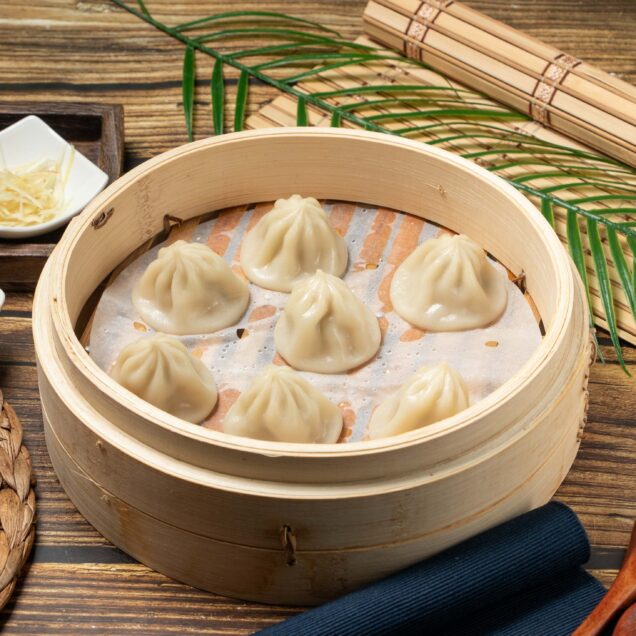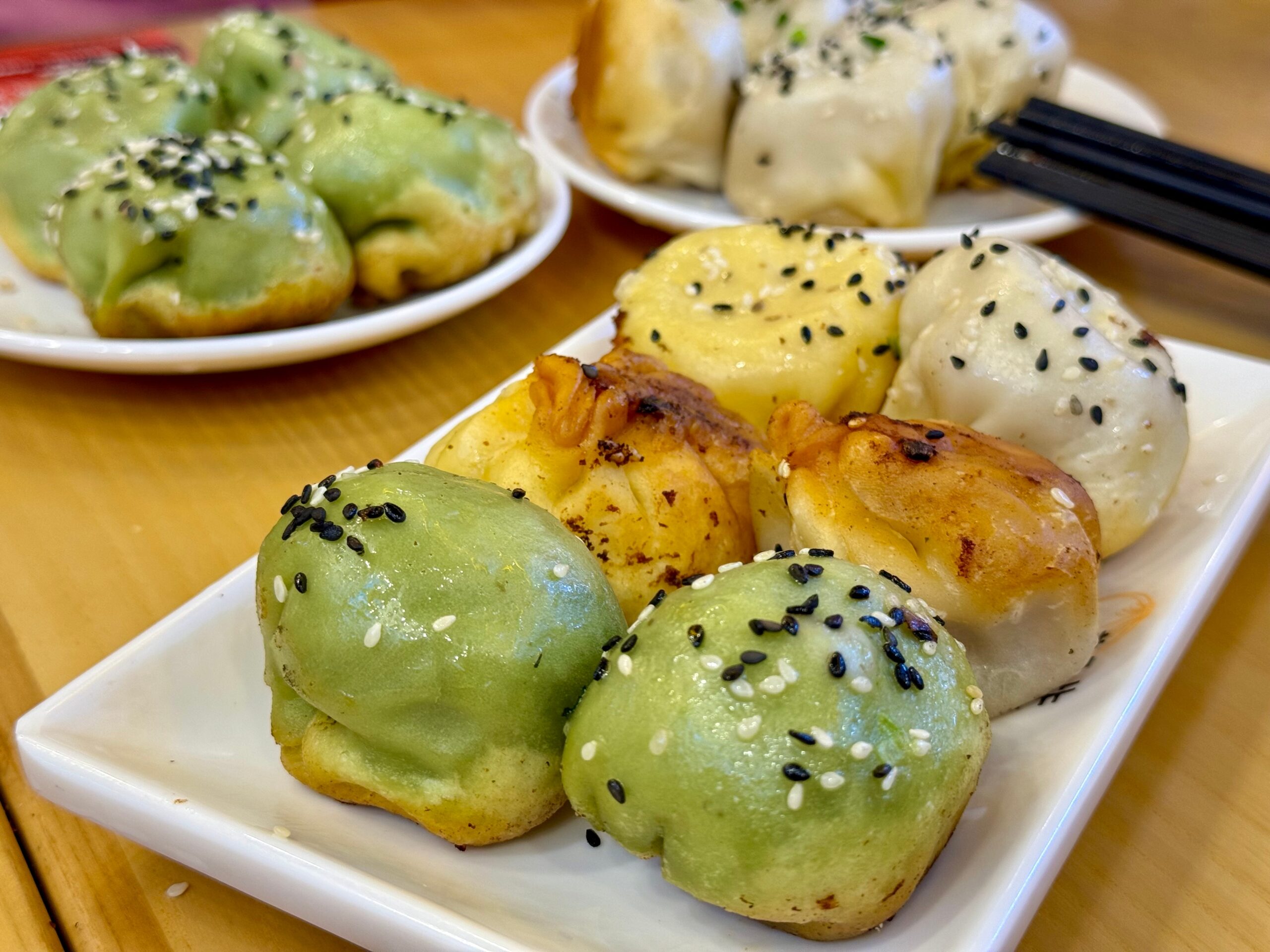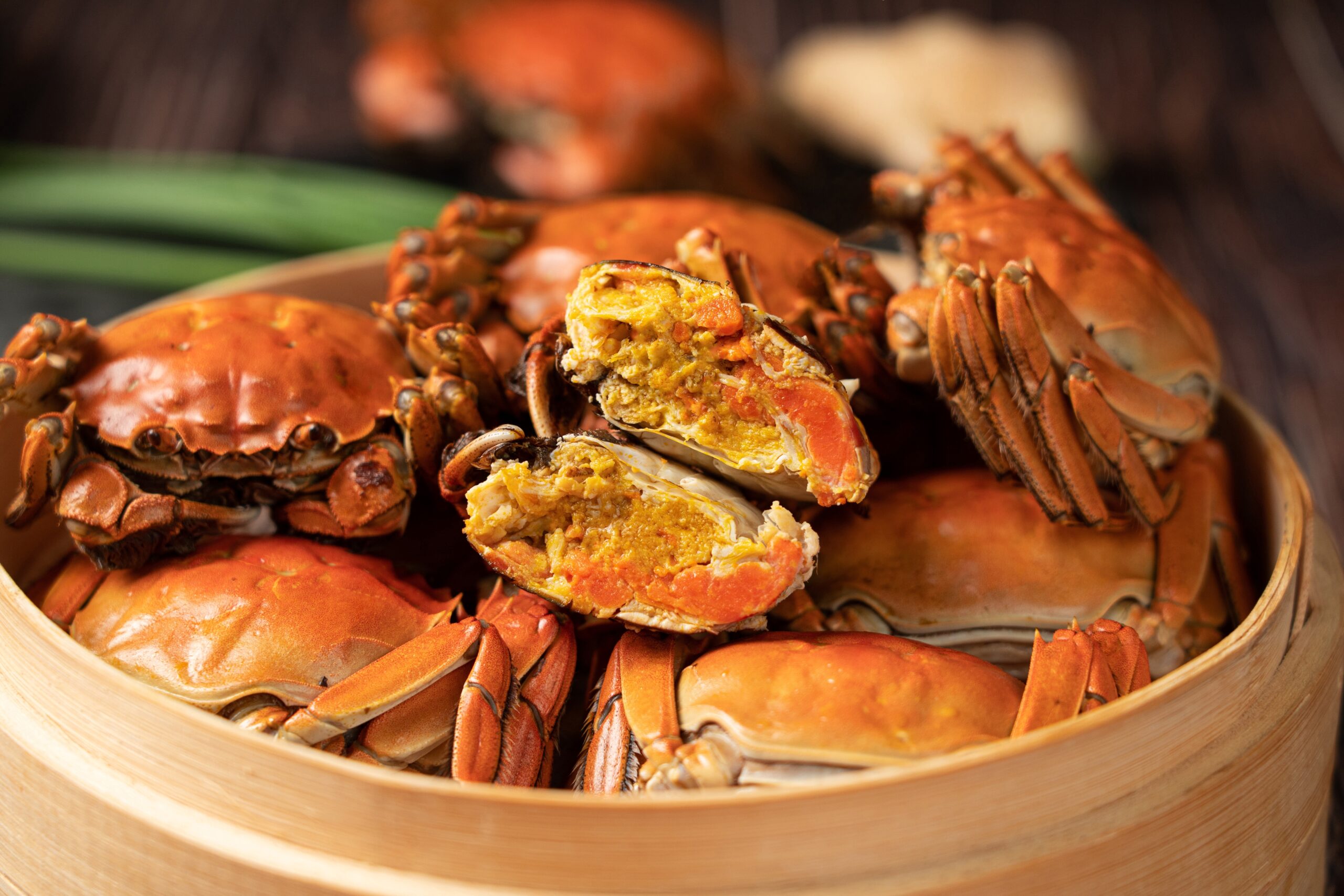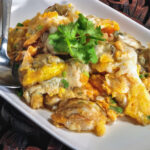Shengjian (Pan-fried Bun 生煎包): Shengjian is one of the most famous delicacies in Shanghai, it is made from semi-leavened dough, wrapped around pork and gelatin fillings. Chopped green onions and sesame are placed atop the buns during the cooking process. The bottom skin of Shengjian must be fried until it turns golden-brown and hard with a soft and fluffy taste, the meat inside is fresh and tender, and sesame and green onions are dulcet when chewed. You can have it throughout the day as a snack in many local shops and different flavors can be chosen, including chicken, pork mixed with prawns, and pork mixed with crab meat.
Xiaolongbao (Soup Dumpling 小笼包): Xiaolongbao is a traditional China snack in Shanghai and Zhejiang. It was developed from soup dumplings that originated from the Northern Song Dynasty and then passed to the Jiangnan area. For Shanghainese, it is not only a kind of good tasting snack, but also symbolizes a living attitude that is delicacy and finesse. Foie gras, durian, crab noodles, etc. are all used by Shanghainese for the innovation of Xiaolongbao.
Hairy Crab(大闸蟹): Hairy crabs whose the scientific name is Chinese mitten crabs, are a kind of river crabs. In general, the crabs from Taihu Lake, Gaoyou Lake and Yangcheng Lake at the lower reaches of the Yangtze River are considered as the top grade, most of the hairy crabs you eat in Shanghai also come from these places. Shanghai does not produce hairy crabs locally, but the locals are obsessed with it for a long time and making it become an important part of Shanghai cuisine. Shanghainese also mixed crab meat into various delicacies such as noodles, wontons and xiaolongbao so they can have crabs everywhere.
Eight-Treasure Duck(Babao Duck 八宝鸭): Eight-Treasure Duck is a traditional delicacy from Suzhou and Shanghai, featuring a whole deboned duck stuffed with glutinous rice, ham, lotus seeds, mushrooms, shrimp, and other flavorful ingredients. Slowly braised or steamed to perfection, the dish achieves a tender texture and a harmonious blend of flavors. With its glossy, reddish hue, succulent meat, and aromatic filling, it offers a rich yet well-balanced taste, making it a distinguished delicacy in the Jinling cuisine.
Sautéed Shelled Shrimps(水晶虾仁): Sautéed Shelled Shrimps is a hallmark of Shanghai cuisine and was once named the “No.1 Dish of Shanghai.” Known for its translucent appearance and delicately bouncy texture, this dish showcases the natural sweetness of fresh shrimp. The fresh shrimp are prepared, lightly coated in starch, briefly blanched, and then gently stir-fried in warm oil to maintain their tenderness. This beautiful dish is bright in color and fragrant, and refreshingly clean on the palate.
White-Cut Chicken(白斩鸡): White-Cut Chicken is a beloved classic in Shanghai cuisine, prized for its tender, juicy meat and pure, natural flavor. A plump, fresh chicken is gently poached, sliced, and served with a fragrant ginger-scallion soy sauce or garlic dip. This simple yet refined dish highlights the chicken’s original taste, with silky, delicate skin and firm yet succulent meat, making it a must-try Shanghai local food during your China trip.
Stir-Fried Shrimps(油爆虾): Stir-Fried Shrimps is a signature dish in Shanghai and Jiangsu cuisine, known for its crisp, golden exterior and juicy, flavorful interior. Fresh river shrimp are first deep-fried in hot oil until crispy, then quickly stir-fried with rice wine, soy sauce, scallions, ginger, and garlic to enhance their umami-rich taste. The shrimp turn a vibrant red, with a crisp shell that peels away effortlessly, revealing tender, succulent meat.
Shanghai Chongming Rice Cake(Shanghai Glutinous Rice 崇明糕): Chongming Rice Cake is a traditional pastry from Shanghai’s Chongming region, crafted primarily from glutinous and japonica rice, enriched with red dates, walnuts, and raisins. It has a soft, chewy texture with a subtle sweetness that is light yet satisfying. The preparation process includes soaking, grinding, and steaming the rice flour to achieve a fine and fluffy consistency. There are two variations: “soft rice cake”, which has a dense, velvety texture when served cold, and “firm rice cake”, which becomes pleasantly elastic when heated and is sometimes paired with fermented rice wine. With its fragrant aroma and melt-in-the-mouth texture, Chongming Rice Cake is a cherished local delicacy. This pastry is also a perfect choice to bring to your friends and family for Chinese taste.
Yan Du Xian(腌笃鲜): Yan Du Xian is one of Shanghai cuisine’s most iconic springtime dishes, renowned for its rich flavors and nourishing qualities. The name reflects its key elements: “Yan” refers to cured pork, “Du” means slow simmering, and “Xian” signifies fresh meat. This dish is made by gently braising fresh bamboo shoots with salted pork and fresh pork belly or ribs, resulting in a creamy white broth with a deep, savory aroma. The tender-crisp bamboo shoots, the pronounced umami of cured meat, and the succulence of fresh pork create a well-balanced, hearty dish that is a household favorite in Shanghai.
Kou San Si(扣三丝): Kou San Si, a signature of Shanghai cuisine, showcases expert knife skills and precise cooking techniques. The dish features finely julienned ham, chicken, and winter bamboo shoots, meticulously cut and arranged before being steamed and inverted onto a plate. Served in a light, clear broth, it offers a refreshing yet layered flavor profile—savory ham, tender chicken, and crisp bamboo shoots. This dish exemplifies the delicacy of Jiangnan cuisine while also being a nutritious and satisfying traditional dish.
Eight-Treasure Spicy Sauce(Babao Spicy Sauce 八宝辣酱): Eight-Treasure Spicy Sauce is a classic Shanghai dish that evolved from stir-fried chili paste, combining a medley of ingredients for a bold and intricate flavor. With its glossy red hue and multi-layered taste, it harmonizes umami, spice, and a hint of sweetness. This dish brings together the briny freshness of seafood, the hearty depth of meat, and the aromatic richness of savory sauces. Key ingredients include diced chicken, pork tripe, bamboo shoots, dried tofu, green peas, shrimp, seafood sauce, and chili oil. Expertly stir-fried to lock in flavor, it delivers a savory-sweet heat that is both balanced and deeply satisfying, making it an essential Shanghai-style dish, best enjoyed with rice.
Fengjingdingti—Steamed Diced Pig Feet(枫泾丁蹄): Shanghai Fengjing Dingti-steamed diced pig feet is made from pig’s hind feet, accompanied by Shaoxing wine, rock sugar, cinnamon, cloves and other auxiliary ingredients. Fengjing Dingti is crafted with premium Fengjing pork knuckles, braised slowly with soy sauce, Fengjing yellow rice wine, salt, rock sugar, and a carefully selected mix of over a dozen aromatic spices. Braised with three cycles of high flame and slow simmering (三旺三文), the marinade seeps deep into the meat, resulting in a knuckle that is tender yet firm, rich without being heavy, and subtly sweet. When served hot, it’s melt-in-your-mouth tender, while chilled, it retains a delightful fragrance and savory taste.
Caotouquanzi—Fried Pork Rectum with Alfalfa(草头圈子): A Shanghainese dish called caotouquanzi is essentially fried pork rectum with alfalfa. The rectum is referred to as the “circle” in the dish’s name. Since the rectum is shaped like a circle, the dish’s original name, Stir-fried Rectum, was altered to the Stir-fried Circle.
Qingyutufei—Braised Herring Liver(青鱼秃肺): Qingyutufei-braised herring liver is a traditional dish of Shanghai. Broad beans, bamboo shoots, herring livers, etc. are the key ingredients. Its color is golden, and its texture is fat but not greasy,. It is incredibly fresh and fat, and it is as soft as a pig’s brain without being crushed.
Braised Pig Knuckle in Brown Sauce(走油蹄): After the knuckle has been steamed, the skin should be separated from the meat and fried in a skillet until it wrinkles. The skin is then submerged in chilly water. Subsequently, add the pig knuckle’s skin, fat, and lean meat to the mixture and cook over low heat.
Shanghai Smoked Egg(上海熏蛋): The Shanghai smoked egg is a traditional Shanghainese dish that involves smoking shelled or duck eggs. The cooked smoked egg has a smoky-colored surface, a semi-solidified yolk, and a soft feel.
Borscht soup(罗宋汤): Tomatoes, meat, stock, onions, cabbage, etc. are used to make borscht soup, and flour is added to thicken the soup. Shanghai-style borscht traces its roots to Russian borscht but has been adapted over time to suit local ingredients and Shanghainese tastes. This unique variation strikes a delicate balance between tangy and sweet flavors, offering a rich yet light texture that is both hearty and refreshing. The modern version masterfully combines the natural sweetness and acidity of tomatoes with the deep umami of beef, making it a beloved soup in Western-style restaurants throughout Shanghai.
Deep-fried Spare Ribs(上海里脊肉): A staple of the Shanghai Western cuisine, deep-fried spare ribs (also known as Shanghai pork chop) are made using a technique adapted from the Viennese steak, the national dish of Austria. It is deep-fried with European flour granules and a flour batter. It’s soft and crunchy without being oily.
Praties Salad(上海色拉): Like the Olivier salad in Russian cuisine, praties salad is one of the most well-known dishes in Shanghai Western cuisine. It is a type of Shanghainese mixed Western food that was inspired by Western food and then adjusted to suit Shanghainese preferences. Diced red sausage and diced boiling potatoes are combined in the main recipe and dressed with mayonnaise. For color, boiled peas are frequently added. Since apples are sweet and crunchy, they are also frequently sliced and added.
Nanxiang xiaolongbao—Soup dumpling(南翔小笼包): Nanxiang xiaolongbao is a traditional snack in Shanghai. The Northern Song Dynasty capital of Kaifeng is where soup dumplings first appeared. The current soup dumpling has its start in the region south of the Yangtze River, and as it progressed and changed throughout time, its flavors progressively changed. Nanxiang xiaolongbao is very famous in Shanghai. In addition to tasting, you can also try to make this Xiaolongbao yourself.
Glutinous Rice Roll(粢饭糕): Popular in the Yangtze River’s southern region, glutinous rice rolls are a typical snack. It is a kind of pastry that is deep-fried. The glutinous rice roll has a beautiful yellow exterior and a delicate white interior that tastes crunchy and aromatic when you bite into it.
Xiekehuang—Baked Small Round Cake(蟹壳黄): Xiekehuang is a type of little round cake that bears a resemblance to the shell of a cooked crab due to its crisp baked texture and golden or orange color.
Fried Rice Cake with Rib(排骨年糕): Pork ribs with thin, tiny rice cakes that are boiled and blanched in oil. The result is a delicious combination of the robust flavor of the ribs and the soft, crispy rice cakes.
Gaoqiao Small Round Cake(鸽蛋圆子): The Gaoqiao little round cake, so named because of its mouth-feeling crisp and fluffy texture, is one of the four well-known delicacies of Gaoqiao Town, Pudong New Area, Shanghai.
Chaipan Wonton (柴爿馄饨): In Shanghai, chaipan wonton gained popularity during the 1920s and 1940s. The term “Chaipan wonton” originates from the fact that vendors are seen selling their wonton in the middle of the night while cooking over wood fires and drawing customers in with the sound of bamboo boards. “chaipan” is pinyin for “柴爿”. The meaning of this word is sliced wood.
Chicken Blood Soup/Duck Blood Soup(上海鸡鸭血汤): One of the most well-known foods from Shanghai’s City God Temple is chicken and duck blood soup. It was first made in the early 1900s by Xu Fuquan, a street vendor, who boiled the soup in a deep iron pot called a “Tieniu” (铁牛). Featuring aluminum components in the center, half of which was scorched with blood and the other half of which was suspended with chicken soup created from the feet and the head of the chicken. A little portion of the chicken heart, liver, gizzard, intestines, and eggs will be set aside by the chef, who will then add a spoonful of blood broth, scallion, and a few drops of chicken oil. The smoothness, flavor, and tenderness of the liver and intestines, together with the affordable price, made the chicken and duck blood soup a hit with patrons. The taste and freshness of the current version of chicken and duck blood soup have been enhanced by the addition of tofu, bamboo shoots, vermicelli, and other auxiliary ingredients. Additionally, the soup is served in a bowl with a dash of pepper and coriander leaves for an added flavor boost.
Map
More Info
Shanghai Food and Cuisine





